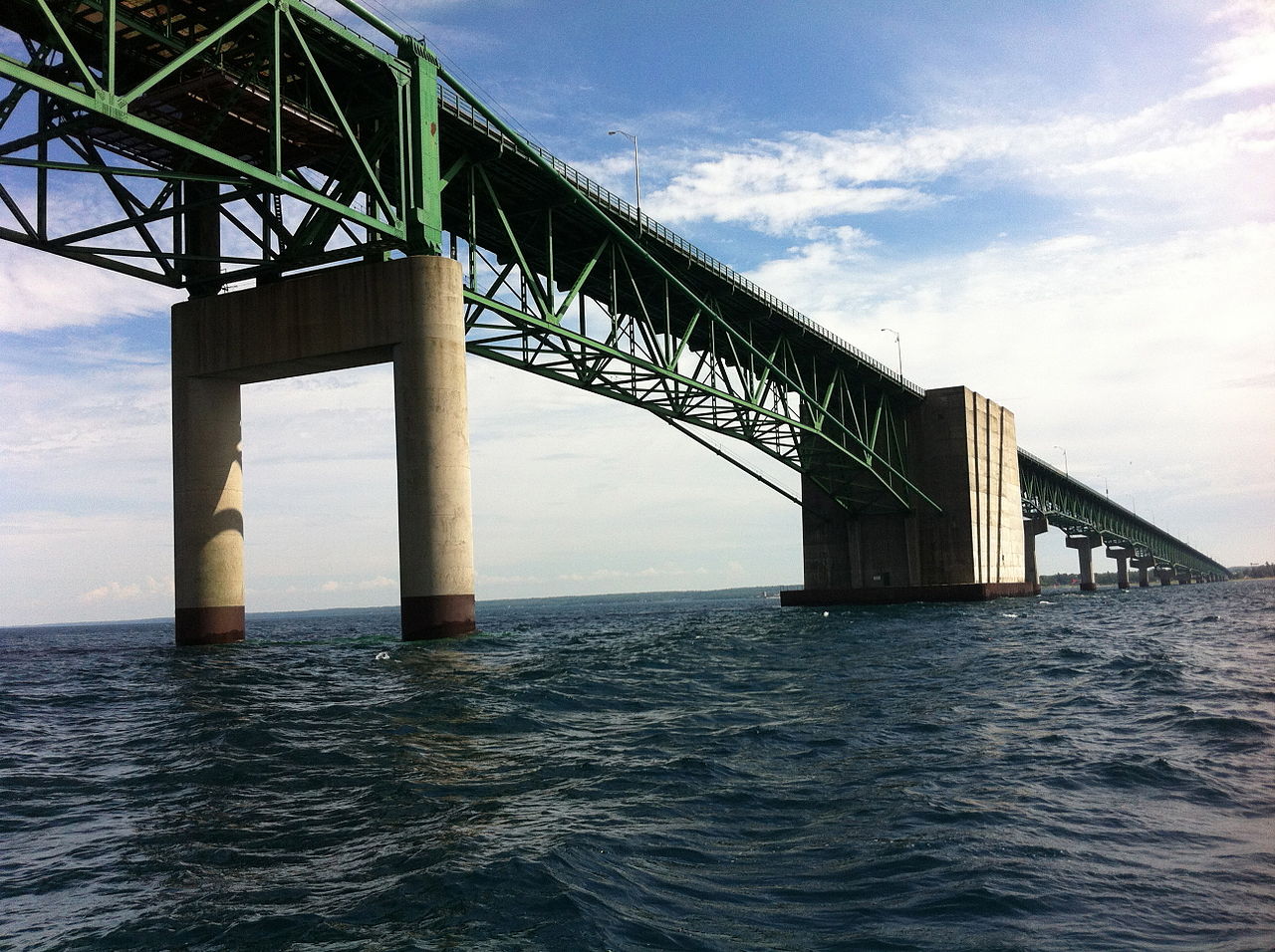
Great Lakes Environmental Groups say it isn’t enough
On Thursday, May 24th, 2018, Michigan’s Governor Rick Snyder approved an emergency rule mandating a no-anchor zone in the Straits of Mackinac where almost a dozen pipelines and power lines carry oil, natural gas liquids and other substances in a 4.5 mile long section under the water near the Mackinac Bridge.

Attorney General Bill Schuette, courtesy of michigan.gov
Michigan’s Attorney General Bill Schuette’s office says on April 1st, a ship “dragged an anchor across the State bottomlands and submerged electric and petroleum pipelines in the Straits of Mackinac, causing the release of hazardous substances and potentially harming aquatic life and the lake bed.” Schuette brought civil action against Vanenkevort Tug and barge in connection with the incident.
The incident damaged and ruptured an ATC power line, spilling 600 gallons of mineral oil containing the potential toxic benzene compound into the Straits where Lake Huron and Lake Michigan connect between Michigan’s Upper and Lower Peninsula. A Unified Command Post was created in Mackinac City, where several agencies spent weeks doing monitoring and clean-up.
The Coast Guard and the Department of Natural Resources say the spill did not harm the water supply or wildlife.
The incident also put two sets of dents in Enbridge’s Line 5 Pipeline which carries 23 million gallons of oil and natural gas liquids across the Straits each day. Enbridge says no structural damage was done to its 65-year old pipeline and there was no threat of a spill.
But the incident created enough concern that there is now an increasing number of voices calling for the shut-down of Line 5 in the Straits.
Now, almost two months after the incident, Governor Snyder says prohibiting anchoring in the Straits of Mackinac — where key infrastructure lines carry important resources between Michigan’s peninsulas — is critical to help prevent irreversible environmental damage to our state.

Michigan Governor Rick Snyder, Photo by Jim Greenhill via wikimedia cc 2.0
As he approved the Department of Natural Resources issuing an emergency rule Governor Snyder said, “Anchoring in the Straits of Mackinac poses a serious threat to the welfare and protection of Michigan and our vital natural resources. Anchoring could cause severe environmental damage and threatens to disrupt critical energy and communication services between the Upper and Lower peninsulas. This emergency rule will help us better protect Michigan waters and residents until a permanent solution is in place.”
The emergency rule formalizes a previously informal anchor restriction in the Straits of Mackinac by prohibiting anchoring under Michigan state law. Governor Snyder’s office says discussions are underway with the U.S. Coast Guard on permanent measures that would complement the state’s temporary emergency rule.
But in the wake of the Governor’s action, confusion reigns.
Many people thought the Straits of Mackinac was already a no-anchor zone. And they are wondering how imposing this new emergency mandate will prevent an accidental anchor drag like the one that occurred in April.
Great Lakes Now is waiting for a statement from the Coast Guard explaining the difference between a “no-anchor advisory” – what was allegedly in place in the straits previously – and the Governor’s new declaration of a “no-anchor zone”’ in the Straits of Mackinac.
We will post the Coast Guard response as soon as we receive it. (See U.S. Coast Guard statement at the end of this story.)
Meanwhile, Great Lakes Now is getting reaction from environmental organizations across the Great Lakes Basin.

Mike Shriberg, Great Lakes regional executive director of the National Wildlife Federation, courtesy of nwf.org
Executive Director of the National Wildlife Federation Regional Center and member of Michigan’s Pipeline Safety Advisory Board Mike Schriberg says, “This commonsense emergency rule is welcome. “ However, he says, “ I was shocked and dismayed to learn at the last Michigan Pipeline Safety Advisory Board meeting that anchoring in this area was not already illegal. However, the rule does not eliminate the risk from anchors since anchor drops can still occur in emergency situations or with ‘prior written permission’. In fact, the only way to fully protect the Great Lakes and our way of life from a Line 5 oil spill is to decommission the pipelines.”
Liz Kirkwood, Executive Director with FLOW (For Love of Water) in Traverse City tells Great Lakes Now , “This is like window dressing for a window that doesn’t have a pane.” Kirkwood says, “What are the optics going on with Line 5 right now? Why are we constantly failing to address the systemic problem which is that we have a 65-year old oil pipeline in the middle of the Great Lakes? Let’s pretend we were doctors. Are we interested in treating the symptoms or the disease?”

Liz Kirkwood, Executive Director of FLOW, by of flowforwater.org
Kirkwood calls Governor Snyder’s actions “a charade.” She says, “I would submit to you that the level of effort we’ve seen from the Snyder administration continues to focus on these systematic problems even when we have these incredible signs we need to take dramatic and significant action to prevent a catastrophic oil spill. We know that this pipeline is aging and Enbridge has continued to do piecemeal fixes on the patient. This is not repair and maintenance. This is a whole-hearted effort to reengineer and extend the lifespan of pipeline infrastructure that had a lifespan of 50 years – not 65 and not 70. It’s long overdue to revoke the easement and protect the Great Lakes by shutting down Line 5. “
Oil & Water Don’t Mix Communications Coordinator David Holtz says, “It is unclear whether Governor Snyder’s temporary emergency rule announced today establishing a no-anchor zone in the Straits of Mackinac would have prevented last month’s anchor strike or will keep Line 5 from rupturing from another anchor strike in the future.”
Holtz says, “As written, the no-anchor rule announced today would not apply to vessels that deploy anchors in emergencies. Moreover, the new rule does not define what constitutes an emergency, presumably leaving the decision to deploy an anchor in the Straits to vessel captains. Implementing a no-anchor rule in the wake of an anchor strike is welcome action by the governor, even if it is belated. But what we need more than anything is for our elected officials to take action before there’s an emergency, especially when the threat is as foreseeable as an oil spill from damaged, unstable pipelines in a shipping lane with the most turbulent waters in the Great Lakes. Decommissioning Line 5 is the only thing that will protect the Great Lakes from a catastrophic pipeline rupture. Michigan shouldn’t have to wait until Line 5 ruptures for the governor and attorney general to act to decommission Line 5. “
Executive Director of Freshwater Future Jill Ryan says the Governor’s emergency mandate “is absolutely necessary to reduce the potential for damage to the oil pipelines called Line 5 under the Straits of Mackinac, as well as other infrastructure such as the electric utility line that leaked over 550 gallons of insulating oil after an anchor strike last month.” She says “given the potential for damage from anchor strikes, which are ranked as the highest risk to the pipelines that carry nearly 23 million gallons of oil per day under our Great Lakes in this area, I would say this action is long overdue.”
Several Great Lakes lawmakers are applauding Governor Snyder’s mandate.
State Senator Wayne Schmidt says, “Michigan is blessed with some of the most beautiful natural resources on the planet — and with that comes a tremendous responsibility. While I am thankful that no harm was done to the environment, we must ensure that an incident like the one in early April never happens again. Studies have shown that the highest risk to underwater pipelines and cables is a deployed anchor and I am happy to see the DNR acting to prohibit this from happening again by instituting this emergency ruling.”

State Representative Lee Chatfield , Photo by gophouse.org
State Representative Lee Chatfield says “Anchor strikes in the Straits of Mackinac represent a clear and present danger to the people and natural resources of Northern Michigan and the Upper Peninsula. I believe this Emergency Rule should be permanent. Let there be no confusion: From this day forward, dropping anchor in the Straits will be an illegal act and should be treated with the full weight of the law. A spill would endanger and affect the well-being of people living in the entire region. The Straits and inland waterways aren’t just important to our economy, they are a big part of our way of life.”
The emergency rule will remain in place for 6 months, with the option of an additional 6-month renewal. The eastern boundary of the no-anchor zone is defined by the Mackinac Bridge. The western boundary is defined by a line beginning at the western edge of McGulpin Point in the Lower Peninsula to the western edge of an unnamed island immediately southwest of Point La Barbe in the Upper Peninsula. Click here to view a map of the boundaries.
We have just heard back from the U.S Coast Guard. Here is the agency’s response to questions from Great Lakes Now:
GLB: How do mariners know right now not to drop their anchors in the vicinity of Straits of Mackinac where there are pipelines and cables under the water near the Mackinac Bridge?
U.S. Coast Guard: Professional Mariners that have made a career of operating cargo ships, earn and maintain ‘Merchant Mariner Credentials’. These credentials, for both U.S. and Foreign vessel masters, require frequent trainings, courses and continuing education to maintain the licensing and endorsements to operate these ships. All that being said, the overarching principal applied to every aspect of a sea voyage is ‘Prudent Seamanship’.
Voyage planning, using applicable charts with up-to-date corrections, is referenced to plot every waypoint, leg, turn, and depth of water from Point A to Point B. This care and attention is also given with respect to avoiding other hazards along the route including obstructions like sunken wrecks, bridges crossing over waterways and submerged pipelines/cables.
Unless faced with a life-threatening emergency while underway, a vessel master will know to avoid intentionally anchoring there, because of their inherent and mandatory familiarity with the chart. Another tool that is used by the Coast Guard for emergent waterway changes that mariners must be made aware of, is the Safety Broadcast Notice to Mariners. These messages are transmitted over maritime radio frequencies to express real-time critical info.
GLB: What will be the difference for mariners in the straits from BEFORE the Governor enacted this 6 month “No Anchor Zone” in the Straits of Mackinac and and AFTER the “No Anchor Zone” is in place?
U.S. Coast Guard: The cautionary statement and charted location of the submerged cables and pipelines have likely been printed on charts since the day they were constructed. With the signing into effect of a ‘No Anchor Zone’ or “Anchoring Prohibition” rule, the State/DNR has galvanized that warning area into a law. The Ninth Coast Guard District is now drafting a Federal Rulemaking to create a more permanent version of that law, since we are in the business of enhancing navigational safety of the Nations waterways.
At the Federal level, this area will be what is called a “Regulated Navigation Area” or RNA for short. It identifies a hazard and mandates how traffic proceeds through that area. During the drafting process, there will be a 30 day public comment period and all the details will be posted in the Federal Register. Once all is said and done, this rule will be added to the Code of Federal Regulations.
GLB: In the recent anchor-dragging incident that ruptured a powerline and dented the Line 5 Pipeline, it is believed the ship accidentally dragged its anchors for a long period of time and the crew simply did not know its anchors had deployed. How could this new order prevent something like this from happening again?
U.S. Coast Guard: It’s not my place to say whether or not this will prevent future (intentional/unintentional) anchor damage to the submerged pipes and cables within the Straits. It’s an available regulatory mechanism that collaboratively with other efforts- is intended to work to better protect a known vulnerable area from damage.
Featured Image: Mackinac Bridge from Straits of Mackinac, Photo by Gregory Varnum via wikimedia cc 3.0




